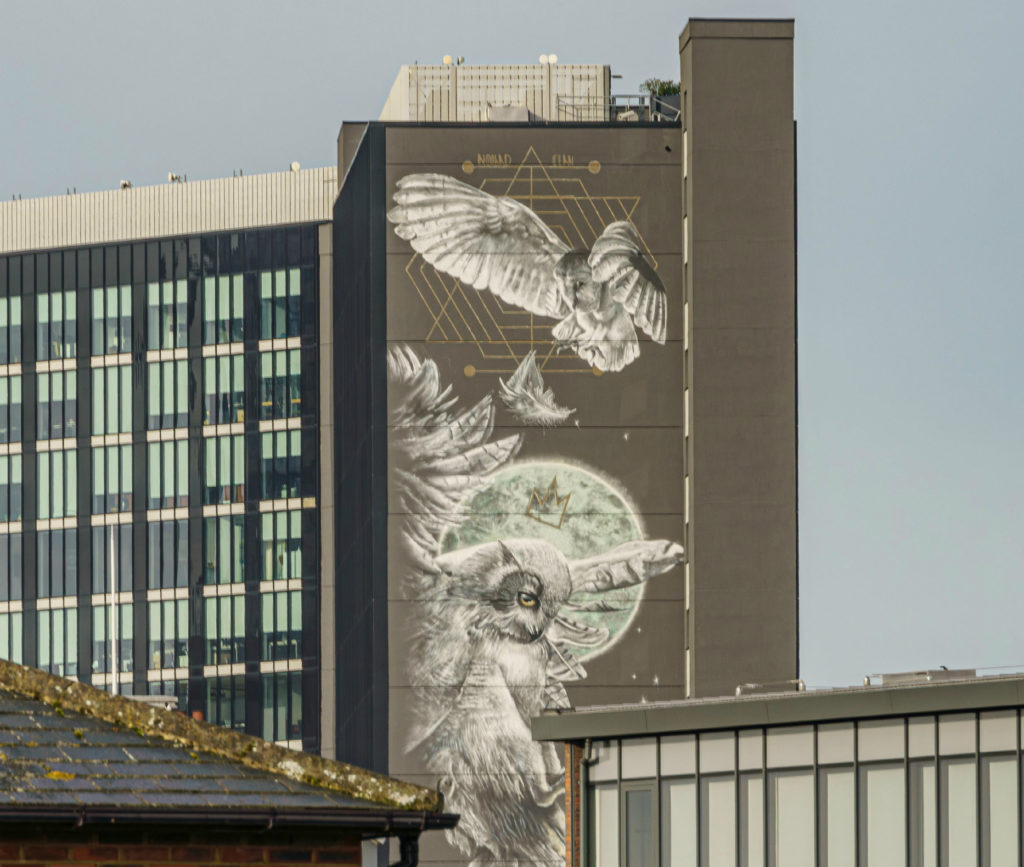Commercial Feature
Britain’s Biggest Murals (and How They Were Painted)

From a riot of colour racing 82 metres up Leicester’s skyline to a nocturnal owl towering over Leeds station, the UK has embraced large-format street art. Here’s a ready-to-publish feature that spotlights the most spectacular murals — and, where it’s on record, how the artists actually got paint onto those giant walls.
What counts as “biggest”?
For this round-up we’ve prioritised height (where published) and noted area where that was the main metric reported by organisers or venues. Facts are drawn from festival pages, city mural trails, artist/organiser announcements and reputable press — and we’ve highlighted the method (powered access, scaffold, rope, etc.) when it’s explicitly documented.
The headliners
St George’s Tower, Leicester — 82 m (Europe’s tallest)
Leicester’s “Blue Tower” was transformed during Bring The Paint, creating what the Guardian called “Europe’s tallest piece of street art” at 82 metres. Local partners back up the figure: see the Leicester BID write-up and project page from Graffwerk.
Athena Rising, Leeds (pictured above) — 46.8 m × 11 m (Nomad Clan)
Once the UK height record-holder, Nomad Clan’s luminous owl still dominates the tracks beside Leeds Station. The 46.8 m height is confirmed in LeedsBID’s “A City Less Grey” project page and referenced in sector press, including the Planning Awards coverage.
“Connected”, Holiday Inn, Belfast — 32 m × 14.5 m (Aches)
Unveiled October 2024 and billed as the island of Ireland’s largest by square footage (≈450 m²). Dimensions and claim are published by the Linen Quarter BID and echoed on their project page.
Union Point, Aberdeen — 12 floors (Hera)
Painted for Nuart Aberdeen 2024, Hera’s harbour-side portrait spans twelve storeys on a wind-lashed corner of the city. Read features from Inspiring City and city partner Aberdeen Inspired.
St Mungo, Glasgow — gable-end landmark (Smug)
One of Britain’s most photographed murals, Smug’s contemporary take on the city’s patron saint anchors the official Glasgow City Centre Mural Trail.
“From Ipswich with Love”, University of Suffolk — region record (ATMA)
Celebrated as the largest mural in East Anglia, the university cites 576 m² on its official news page. Construction media photographed a Niftylift HR28 in the cradle during installation.
How the really big ones get painted
Large-format murals are feats of logistics as much as art. Where methods are on record, they underline how common powered access is on tall façades:
Cherry pickers and MEWPs on major London walls. Shepard Fairey’s Envision in Haringey was created “hoisted aloft by a rented cherry picker,” reported the Guardian. ROA’s famous Hanbury Street Crane was likewise painted “from a motorised cherry picker,” according to Spitalfields Life. Street-art site Inspiring City documented Martin Ron “high on a cherry picker” on his Hanbury Street Guardsman.
Festival infrastructure. Upfest — Europe’s biggest street-art festival — openly lists “scaffolding, cherry pickers and power access equipment” among core costs in its funding pages and crowdfunders.
Of course, scaffolds, cradles and rope access all play their part, depending on façade, pavement loadings and permit constraints. But when a wall is tall, time-sensitive and street-facing, mobile elevating work platforms (MEWPs) often win on speed and disruption.
Five more notable UK murals to seek out
Leicester’s Blue Tower animal totems.
Leeds’ station-side owl (Nomad Clan.
Nuart Aberdeen’s 2024 wave.
Smug’s Glasgow classics.
Ipswich’s waterfront giant (ATMA).
Commissioning a giant mural? Plan the access as carefully as the art
Even when a scheme is privately funded and on private land, you’ll usually be operating in public space and at height. That means selecting the right access method, checking wind thresholds for the chosen kit, and lining up permits or traffic management in advance so the artist can focus on painting.
“Large walls are fantastic for cities — but they’re also complex worksites. The safest, least disruptive installs start with a simple plan: match the platform to the wall, check wind thresholds for the chosen kit, and lock in permits and traffic management before you lift a brush. When artists and estates teams get that right, everything else flows.” — Andy Bray, Managing Director, Access Platform Sales.
From Leicester’s sky-high totems to Glasgow’s gable-end icons, Britain’s largest murals are more than spectacle—they’re civic assets that draw visitors, spark pride and turn everyday streets into open-air galleries. Behind each wall is a quiet choreography of organisers, engineers and access specialists making it safe for artists to work at height. If you’re planning one, treat the logistics with the same care as the design: choose the right method, respect wind limits and secure the necessary permissions so creativity isn’t left waiting at ground level. Do that, and the next landmark on the skyline might just be yours.
 News / Uni redundancy consultation ‘falls short of legal duties’, unions say6 December 2025
News / Uni redundancy consultation ‘falls short of legal duties’, unions say6 December 2025 News / Cambridge students accused of ‘gleeful’ racist hate crime4 December 2025
News / Cambridge students accused of ‘gleeful’ racist hate crime4 December 2025 News / Researchers find five stages of brain development5 December 2025
News / Researchers find five stages of brain development5 December 2025 Music / The trials and tribulations of indie collabs 6 December 2025
Music / The trials and tribulations of indie collabs 6 December 2025 News / Cambridge cosies up to Reform UK30 November 2025
News / Cambridge cosies up to Reform UK30 November 2025




